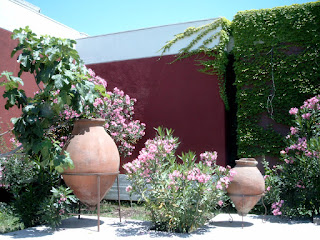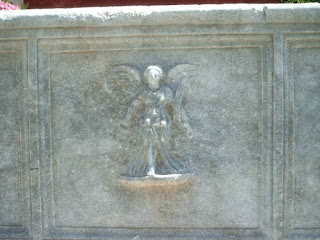This book is the first in a series about
archaeological sites in Libya. The present volume, published in 2009, covers Tripolitania, the western part
of the country. The second volume, published in 2013, covers Cyrenaica, the eastern part of the
country. The third and final volume will cover Fezzan, the southern part
of the country.
Philip Kenrick – the author of the first
volume – is a classical archaeologist who has worked extensively in Libya, both
on excavations and on field surveys.
This book comes highly recommended: on the flap
of the back cover we find a statement by professor David Mattingly, a
well-known authority on ancient Libya, and the author of a book (published in 1995)
with the same title: Tripolitania. His statement concludes with these words:
“Don’t waste your money on lesser products, this is THE guidebook to Libya’s
archaeology.”
Can the book live up to this praise? If you
ask me, the answer is yes. The material is well-organised, and the text is
written by an author who knows his topic very well.
The book begins with a brief introduction that
provides the historical background. The main part of the book (the gazetteer)
is divided into seven chapters. The book concludes with a glossary, a
chronological table, a bibliography and an index.
There are 113 illustrations, including colour
photos and drawings, i.e. maps and plans which show the layout of an ancient town or of an ancient building.
The large and famous sites – such as Sabratha
and Lepcis Magna - are easy to find. Other sites - such as Ghirza - are not so
easy to find. Maybe they are in a remote area. Maybe there is not a good road
leading to the entrance. For these cases, the author gives detailed driving instructions.
In addition, he gives the GPS coordinates, latitude and longitude. You cannot
be more precise than that.
Kenrick uses a star-system to rate the sites
and - within the larger sites - the individual monuments and museums (the highest: 3 stars; the lowest: no stars). This is a
good idea. Most travellers do not have the time or indeed the desire to see
everything. They just want to see the most important attractions.
I like this book, but I
have to mention a few things that bother me. Hopefully, these (minor) flaws
will be corrected if there is a second printing or a second edition of the
book.
** Page 59: ”They shows…”
The grammar!
The grammar!
** Page 63: ”The theatre is undoubtedly the most
striking monument at Sabratha, and deservedly so.”
You cannot discuss whether a building is
striking or not. He should have used the word ”famous” instead of ”striking” or simply
deleted the last three words.
** Page 64: ”At either end of the stage,
passageways (vomitoria) led directly into the orchestra from the outside.”
The passageway leading directly to
(or from) the orchestra is known by the Greek word parodos (plural: parodoi).
The Latin word vomitoria is used to describe the passageways leading from the auditorium
to the outside. The audience exited the building through the arcades on the
back side. It looked as if the theatre was spitting them out. Hence the word vomitoria.
** Page 67, about the amphitheatre of Sabratha:
”The seats are well-preserved…”
I wish this was true, but I am afraid it is
not.
** Page 99: ”But this was part only of the
scheme.”
The order of the words is wrong.
The order of the words is wrong.
** Page 112, about two temples in Lepcis Magna:
”The top of the podium of this temple was also linked to that of Liber Pater by
means of arches which spanned the narrow intervening street.”
This arrangement is rare, but not unique.
There is a similar case in Sufetula in present-day Tunisia where three temples built next
to each other are linked by means of arches. I think the author should have mentioned
this parallel.
** Page 112: ”As one leaves the Old Forum at the
N corner, …, there lie on the ground to the R, just on the foreshore, three
huge columns of cipollino marble.”
The columns are there, whether you leave the
forum or not. It would be better to say: When you leave the Old Forum at the N
corner, you will see three huge columns of cipollino marble lying on the
ground…
** Page 124, about the Hunting Baths at Lepcis
Magna: ”it was possibly to restore the vaulted roofs…”
Not possibly, but possible.
** Page 132: ”In its final form, the circus at
Lepcis was 450 m long and 70
m wide.”
The author has confused the the inside
dimensions (the racetrack) (420 x 70 m) with the outside
dimensions (racetrack + auditorium) (450 x 100 m).
** Page 136, about the museum at Lepcis Magna: ”Just inside the entrance, on the right-hand
wall, is a large artist’s impression of the ancient city seen from the air.”
When he puts it like this, we think the artist
is very large. But the drawing is very large.
** Page 217, the chronological table: ”161-166:
Lucius Verus.”
Lucius Verus was emperor until his
death in 169.
** The bibliography on pp. 219-220: Kenrick
does not mention an important work edited by J.M. Reynolds and J.B. Ward-Perkins: The
Inscriptions of Roman Tripolitania, published by the British School at Rome in
1952. Since 2009 the sources of this valuable collection have been
available as an online database established by King's College. Here is a link: The Inscriptions of Roman Tripolitania.
This book has 232 pages, but it is a
slim volume. It fits into a large pocket, and certainly into a handbag or a
shoulder bag. Be sure to take it with you when you go to Libya. You do not want
to miss a single detail that is mentioned in this excellent guidebook.
* * *
Philip Kenrick,
Libya Archaeological Guides: Tripolitania,
Silphium Press, 2009, 232 pages
* * *







































